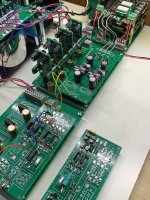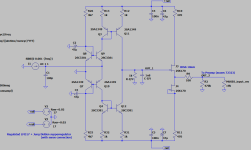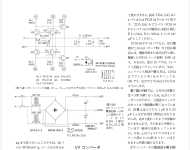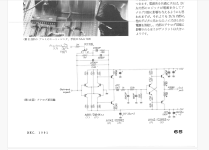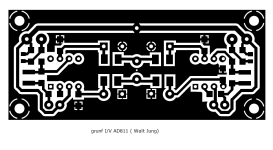What about AD8009?
Higher current, higher slew rate, higher bandwidth and some other pretty impressive specs (for ex. bandwith still higher with gain of 10 than what AD811 can even do with gain of 2), both are current feedback.
SOIC-8 but can be easily adapted to DIP8 with adapter (though probably not achieving 1ghz anymore, though that is just overkill for audio use anyway) or soldered on.
I mean if we're taking AD811 for I/V, might as well bring it to its logical conclusion?

LM7171 might be another to check out
Higher current, higher slew rate, higher bandwidth and some other pretty impressive specs (for ex. bandwith still higher with gain of 10 than what AD811 can even do with gain of 2), both are current feedback.
SOIC-8 but can be easily adapted to DIP8 with adapter (though probably not achieving 1ghz anymore, though that is just overkill for audio use anyway) or soldered on.
I mean if we're taking AD811 for I/V, might as well bring it to its logical conclusion?
LM7171 might be another to check out
How about to maybe made some discrete current feedback circuit similar to AD811?AD811 is TOP(for me at this moment
Or maybe to find some internal simplified diagram to start with?
Its LF noise corner looks considerably worse (higher) than AD811's.What about AD8009?
True, though i will try it maybe and see if it will be an issue in real world. So many benefits but only drawback is "marginally" worse noise below 1khz. Look at OPA1656 voltage noise density graph, order of magnitude worse than either and still considered "ultra low noise" and inaudible.
Interesting how they're both nominally 1.9nv/rHz but the AD8009 specifies it for 10Mhz while the AD811 1khz. And then the knee is worse, as you noted.
Btw, i did not even notice first time, but another benefit is even lower inverting input imppedance (8 vs 14 ohm). For some dacs very important..
Of course paper specs are on paper, i have not looked at the topology of the AD800x family at all other than its AD's XFCB process node.
There is also AD8007, with better distortion but lower slew rate and even worse noise.
Overall i think it does not hurt to experiment with in production parts, AD811 we have already established as a great performer.
Interesting how they're both nominally 1.9nv/rHz but the AD8009 specifies it for 10Mhz while the AD811 1khz. And then the knee is worse, as you noted.
Btw, i did not even notice first time, but another benefit is even lower inverting input imppedance (8 vs 14 ohm). For some dacs very important..
Of course paper specs are on paper, i have not looked at the topology of the AD800x family at all other than its AD's XFCB process node.
There is also AD8007, with better distortion but lower slew rate and even worse noise.
Overall i think it does not hurt to experiment with in production parts, AD811 we have already established as a great performer.
Yes true but it is not easy to find as obsolete part?
I found DIP8
https://www.digikey.com/en/products/detail/analog-devices-inc/AD811ANZ/671056
.
And because of overhating (i have to use huge Heatsink, much bigger than in the Jung example), and lower PS voltage values...
I found DIP8
https://www.digikey.com/en/products/detail/analog-devices-inc/AD811ANZ/671056
.
And because of overhating (i have to use huge Heatsink, much bigger than in the Jung example), and lower PS voltage values...
AD8009 could be a winner. I wonder if it can be dropped in grunf's circuit without any change of components. I certainly will order a pairTrue, though i will try it maybe and see if it will be an issue in real world. So many benefits but only drawback is "marginally" worse noise below 1khz. Look at OPA1656 voltage noise density graph, order of magnitude worse than either and still considered "ultra low noise" and inaudible.
Interesting how they're both nominally 1.9nv/rHz but the AD8009 specifies it for 10Mhz while the AD811 1khz. And then the knee is worse, as you noted.
Btw, i did not even notice first time, but another benefit is even lower inverting input imppedance (8 vs 14 ohm). For some dacs very important..
Of course paper specs are on paper, i have not looked at the topology of the AD800x family at all other than its AD's XFCB process node.
There is also AD8007, with better distortion but lower slew rate and even worse noise.
Overall i think it does not hurt to experiment with in production parts, AD811 we have already established as a great performer.
Sim says it can but will have to try, not sure how elaborate the included ltspice model is but i wouldn't be surprised if you can drop it in. For AD811 values for the "compensation resistor" and output resistor we are using make it pretty stable all things considered, on well implemented board should be fine but dont take it for granted (i am working on one right now). Stability also depends on your load capacitance and other things. You can raise the 10ohm output resistor to 50-100 if you have a highly capacive load. Also remember, +-6V max for this one.
Also here is some light reading from W. Jung himself on the topic.
Also here is some light reading from W. Jung himself on the topic.
AD8009 has double the current noise with respect to the AD811, too.
I think in the actual I/V conversion scheme, and with the dac output impedance ~high-is, 1kohm range, that contributes much more than the noise corner difference..
So: it's less dynamic range, and definitely more noisy than AD811..
There are TI CFB amps that have much less current noise, even less than 811, and are high power rail (+_15V ) capable, as the 811..
THS 3091, 3095, THS 3491 /95
(There had been much talk about NE5534A & competitors, and 'in' ..
1,8pA/sqrtHz -3 pAsqrt/Hz were called 'horrendous' 🙂🙂
- 811 is 20pA/sqrtHz, 8009 is 45pA/sqrtHz.. what should 8t be called, now..🤔😜)
I think in the actual I/V conversion scheme, and with the dac output impedance ~high-is, 1kohm range, that contributes much more than the noise corner difference..
So: it's less dynamic range, and definitely more noisy than AD811..
There are TI CFB amps that have much less current noise, even less than 811, and are high power rail (+_15V ) capable, as the 811..
THS 3091, 3095, THS 3491 /95
(There had been much talk about NE5534A & competitors, and 'in' ..
1,8pA/sqrtHz -3 pAsqrt/Hz were called 'horrendous' 🙂🙂
- 811 is 20pA/sqrtHz, 8009 is 45pA/sqrtHz.. what should 8t be called, now..🤔😜)
Last edited:
There are TI CFB amps that have much less current noise, even less than 811, and are high power rail (+_15V ) capable, as the 811..
THS 3091, 3095, THS 3491 /95
I had a look at those TI parts, didn't see any with current noise below 15pA/rtHz. 3dB lower than AD811 in HF region but much worse LF noise corners.
@Dendrobium - the lower impedance at the -ve node is an interesting observation. I suspect though that it comes at the expense of increased input bias current and therefore higher current noise.
The problem with ultra fast opamps is they are not optimized for audio distortion. The distortion data is simply not available below 1MHz in the datasheet, and the optimal noise performance is at 40 ohms impedance... It also runs hot and may have drift and thermal distortion issues. Until its been characterized for its actual audio performance its difficult to know how well it performs, and you'll need to be very careful with layout and decoupling with such a beast.What about AD8009?
Higher current, higher slew rate, higher bandwidth and some other pretty impressive specs (for ex. bandwith still higher with gain of 10 than what AD811 can even do with gain of 2), both are current feedback.
SOIC-8 but can be easily adapted to DIP8 with adapter (though probably not achieving 1ghz anymore, though that is just overkill for audio use anyway) or soldered on.
I mean if we're taking AD811 for I/V, might as well bring it to its logical conclusion?
View attachment 1241643
LM7171 might be another to check out
Agreed with all, and yes will have to try it in real circuit to know real performance in audio application. And yes the layout is important, for example most data sheets will already suggest no ground plane under the pins and input traces as they will have parasitic capacitance on the inputs.Stray capacitance on the inverting input and the feedback resistor form a pole, which degrades the phase margin, leading to instability. Excessive stray capacitance on the output also forms a pole, which degrades phase margin. Meaning, there is a lot to think about there..
Hi Grunf, I was playing with the Toshiyuki Beppu topology as well. Experienced some difficulties to achieve the needed gain and the negative feedback was a minus point.Last weekend I made some small changes. Outputs are now 2SA1209/2SC2911 with slightly changed operating points. The current through each IV stage is now +/-40mA.
And the sound? Excellent considering that it has only 6 transistors that still work at slightly higher currents. Much much better than the first version. I hope that there will be further progress, however now comes the more difficult task which is to find output transistors(low cob, high ft, with good hfe) that are easily available at Mouser.
As I also rejected the Pedja Rogic diamond buffer IV stage (after multiple proto builds) due to thermal issues and highly accurate NPN and PNP matching, I simulated quickly below circuit. Bias currents are rock solid and idem to simulation.
Now listening to it!
If this was not flying, my next step was the AD811.
Attachments
I'm not really satisfied with Toshiyuki Beppu either, but I didn't have any problems, the maximum output voltage I got was around 6Vp-p. The sound depends a lot on the output transistors and the current through them. I'm thinking of improving it, but I'm not sure that with some discrete - simple I/V stage I'll reach the quality of the AD811.
Attachments
Hi grunf
Can I ask the dimensions of the board?
I got everything ordered and want to get the board made.
Klaus
Can I ask the dimensions of the board?
I got everything ordered and want to get the board made.
Klaus
- Home
- Source & Line
- Digital Line Level
- AD811 as I/V stage for current DACs (and test some other opamps including Burson Audio opamps as I/V)
